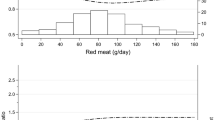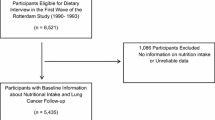Abstract
Objectives: To study the association between diet and lung cancer mortality in the United States.
Methods: Records from 20,195 participants with usable dietary data in the 1987 National Health Interview Survey were linked to the National Death Index. Baseline diet was assessed with a 59-item food-frequency questionnaire. Food groups (fruits, vegetables, total meat/poultry/fish, red meats, processed meats, dairy products, breakfast cereals, other starches, added fats, and alcohol) were analyzed in cause-specific Cox proportional hazard regression models adjusted for age, gender and smoking.
Results: There were 158 deaths from lung cancer (median follow-up 8.5 years). Frequencies of meat/poultry/fish intake (relative risk [RR] (highest compared to lowest quartile) = 2.0; 95% confidence interval [CI] 1.2–3.5, p for trend [p] < 0.027), and red meat intake (RR = 1.6; CI 1.0–2.6, p < 0.014), were positively and significantly associated with lung cancer mortality. Specifically, the red meats, including pork (RR = 1.6; CI 1.0–2.7, p < 0.028), and ground beef (RR = 2.0; CI 1.1–3.5, p < 0.096) were associated with increased risk, although for ground beef the trend was not significant. Dairy products (RR = 0.5; CI 0.3–0.8, p < 0.009) were inversely associated with lung cancer mortality. There was no statistically significant association between intake of fruits and vegetables and lung cancer mortality.
Conclusions: In this nationally representative study, intake of red meats was positively associated with lung cancer mortality while intake of dairy products was inversely associated. While smoking is the major risk for lung cancer mortality, diet may have a contributory role.
Similar content being viewed by others
References
Landis SH, Murray T, Bolden S, Wingo PA (1999) Cancer Statistics, 1999. CA Cancer J Clin 49: 8–31.
US Department of Health Education and Welfare (1964) Smoking and Health. Public Health Service Publ. no.1103. Washington, DC: Government Printing Office.
Willett W (1995) Diet, nutrition, and avoidable cancer. Environ Health Perspect 103: 165–170.
Food, Nutrition and the Prevention of Cancer: a global perspective (1997) World Cancer Research Fund/American Institute for Cancer Research. Washington, DC: American Institute for Cancer Research.
Ziegler RG, Mayne ST, Swanson CA (1996) Nutrition and lung cancer. Cancer Causes Control 7: 157–177.
Chow WH, Schuman LM, McLaughlin JK, et al. (1992) A cohort study of tobacco use, diet, occupation, and lung cancer mortality. Cancer Causes Control 3: 247–254.
Fraser GE, Beeson WL, Phillips RL (1991) Diet and lung cancer in California Seventh-day Adventists. Am J Epidemiol 133: 683–693.
Knekt P, Jarvinen R, Seppanen R, et al. (1991) Dietary antioxidants and the risk of lung cancer. Am J Epidemiol 134: 471–479.
Knekt P, Seppanen R, Jarvinen R, et al. (1991) Dietary cholesterol, fatty acids, and the risk of lung cancer among men. Nutr Cancer 16: 267–275.
Wu Y, Zheng W, Sellers TA, Kushi LH, Bostick RM, Potter JD (1994) Dietary cholesterol, fat, and lung cancer incidence among older women: the Iowa Women's Health Study (United States). Cancer Causes Control 5: 395–400.
Kvale G, Bjelke E, Gart JJ (1983) Dietary habits and lung cancer risk. Int J Cancer 31: 397–405.
Shekelle RB, Rossof AH, Stamler J (1991) Dietary cholesterol and incidence of lung cancer: the Western Electric Study. Am J Epidemiol 134: 480–484.
Veierod MB, Laake P, Thelle DS (1997) Dietary fat intake and risk of lung cancer: a prospective study of 51,452 Norwegian men and women. Eur J Cancer Prev 6: 540–549.
Gordon T, Doyle JT (1987) Drinking and mortality. The Albany Study. Am J Epidemiol 125: 263–270.
Klatsky AL, Armstrong MA, Friedman GD (1981) Alcohol and mortality: a ten-year Kaiser-Permanente experience. Ann Intern Med 95: 139–145.
Kono S, Ikeda M, Tokudome S, Nishizumi M, Kuratsune M (1986) Alcohol and mortality: a cohort study of male Japanese physicians. Int J Epidemiol 15: 527–532.
Pollack ES, Nomura AM, Heilbrun LK, Stemmermann GN, Green SB (1984) Prospective study of alcohol consumption and cancer. N Engl J Med 310: 617–621.
Potter JD, Sellers TA, Folsom AR, McGovern PG (1992) Alcohol, beer, and lung cancer in postmenopausal women. The Iowa Women's Health Study. Ann Epidemiol 2: 587–595.
Thun MJ, Peto R, Lopez AD, et al. (1997) Alcohol consumption and mortality among middle-aged and elderly U.S. adults. N Engl J Med 337: 1705–1714.
Layton DW, Bogen KT, Knize MG, Hatch FT, Johnson VM, Felton JS (1995) Cancer risk of heterocyclic amines in cooked foods: an analysis and implications for research. Carcinogenesis 16: 39–52.
Sugimura T (1985) Carcinogenicity of mutagenic heterocyclic amines formed during the cooking process. Mutat Res 150: 33–41.
Wakabayashi K, Nagao M, Esumi H, Sugimura T (1992) Food-derived mutagens and carcinogens. Cancer Res 52: 2092s–2098s.
Sinha R, Knize MG, Salmon CP, et al. (1998) Heterocyclic amine content of pork products cooked by different methods and to varying degrees of doneness. Food Chem Toxicol 36: 289–297.
Sinha R, Rothman N, Salmon CP, et al. (1998) Heterocyclic amine content in beef cooked by different methods to varying degrees of doneness and gravy made from meat drippings. Food Chem Toxicol 36: 279–287.
Byrne C, Sinha R, Platz EA, et al. (1998) Predictors of dietary heterocyclic amine intake in three prospective cohorts. Cancer Epidemiol Biomarkers Prev 7: 523–529.
US Preventive Services Task Force (1996) Guide to Clinical Preventive Services, 2nd edn. Baltimore: Williams & Wilkins.
Cox CS, Mussolino ME, Rothwell ST, et al. (1997) Plan and operation of the NHANES I Epidemiologic Followup Study, 1992. Vital Health Stat 1: 1–23.
National Center for Health Statistics (1985) The National Health Interview Survey Design, 1973-1984, and Procedures, 1975-1983. Series 1, Number 18, DHHS Publ. No. (PHS) 85-1320. Hyattsville, MD: Department of Health and Human Services, pp. 8l5–1320.
National Center for Health Statistics, Schoenborn CA, Marano M (1988) Current Estimates from the National Health Interview Survey: United States, 1987. Vital and Health Statistics, Series 10, No. 166. DHHS Publ. No. (PHS) 88-1594. Washington, D.C.: Government Printing Office, pp. 1–233.
Patterson BH, Bilgrad R (1986) Use of the National Death Index in cancer studies. J Natl Cancer Inst 77: 877–881.
Horm JW, Wright RA (1993) A new national source of health and mortality information in the United States. Proc Am Stat Assoc 256–261.
Block G, Hartman AM, Dresser CM, Carroll MD, Gannon J, Gardner L (1986) A data-based approach to diet questionnaire design and testing. Am J Epidemiol 124: 453–469.
Block G, Dresser CM, Hartman AM, Carroll MD (1985) Nutrient sources in the American diet: quantitative data from the NHANES II survey. II. Macronutrients and fats. Am J Epidemiol 122: 27–40.
Block G, Dresser CM, Hartman AM, Carroll MD (1985) Nutrient sources in the American diet: quantitative data from the NHANES II survey. I. Vitamins and minerals. Am J Epidemiol 122: 13–26.
Sobell J, Block G, Koslowe P, Tobin J, Andres R (1989) Validation of a retrospective questionnaire assessing diet 10-15 years ago. Am J Epidemiol 130: 173–187.
Block G, Woods M, Potosky A, Clifford C (1990) Validation of a self-administered diet history questionnaire using multiple diet records. J Clin Epidemiol 43: 1327–1335.
Mares-Perlman JA, Klein BE, Klein R, Ritter LL, Fisher MR, Freudenheim JL (1993) A diet history questionnaire ranks nutrient intakes in middle-aged and older men and women similarly to multiple food records. J Nutr 123: 489–501.
Block G, Thompson FE, Hartman AM, Larkin FA, Guire KE (1992) Comparison of two dietary questionnaires validated against multiple dietary records collected during a 1-year period. J Am Diet Assoc 92: 686–693.
Coates RJ, Eley JW, Block G, et al. (1991) An evaluation of a food frequency questionnaire for assessing dietary intake of specific carotenoids and vitamin E among low-income black women. Am J Epidemiol 134: 658–671.
Block G, Hartman AM, Naughton D (1990) A reduced dietary questionnaire: development and validation. Epidemiology 1: 58–64.
Willett W (1998) Nutritional Epidemiology, 2nd edn. New York: Oxford University Press.
Korn EL, Graubard BI, Midthune D (1997) Time-to-event analysis of longitudinal follow-up of a survey: choice of the time scale. Am J Epidemiol 145: 72–80.
Durrleman S, Simon R (1989) Flexible regression models with cubic splines. Stat Med 8: 551–561.
Scholar EM, Violi LA, Newland J, Bresnick E, Birt DF (1989) The effect of dietary fat on metastasis of the Lewis lung carcinoma and the BALB/c mammary carcinoma. Nutr Cancer 12: 109–119.
Byers TE, Graham S, Haughey BP, Marshall JR, Swanson MK (1987) Diet and lung cancer risk: findings from the Western New York Diet Study. Am J Epidemiol 125: 351–363.
Goodman MT, Kolonel LN, Yoshizawa CN, Hankin JH (1988) The effect of dietary cholesterol and fat on the risk of lung cancer in Hawaii. Am J Epidemiol 128: 1241–1255.
Hankin JH, Zhao LP, Wilkens LR, Kolonel LN (1992) Attributable risk of breast, prostate, and lung cancer in Hawaii due to saturated fat. Cancer Causes Control 3: 17–23.
Jain M, Burch JD, Howe GR, Risch HA, Miller AB (1990) Dietary factors and risk of lung cancer: results from a case-control study, Toronto, 1981-1985. Int J Cancer 45: 287–293.
Swanson CA (1997) Dietary fats and lung cancer risk among women: the Missouri Women's Health Study. Cancer Causes Control 8: 883–893.
Deneo-Pellegrini H, De Stefani E, Ronco A, Mendilaharsu M, Carzoglio JC (1996) Meat consumption and risk of lung cancer; a case-control study from Uruguay. Lung Cancer 14: 195–205.
Mettlin C (1989) Milk drinking, other beverage habits, and lung cancer risk. Int J Cancer 43: 608–612.
Sinha R, Kulldor. M, Crandall J, Brown CC, Alavanja MCR, Swanson CA (1999) Fried, well done red meat and risk of lung cancer in women. Cancer Causes Control 9: 621–630.
Sankaranarayanan R, Varghese C, Duffy SW, Padmakumary G, Day NE, Nair MK (1994) A case-control study of diet and lung cancer in Kerala, South India. Int J Cancer 58: 644–649.
Suzuki I, Hamada GS, Zamboni MM, Cordeiro PB, Watanabe S, Tsugane S (1994) Risk factors for lung cancer in Rio de Janeiro, Brazil: a case-control study. Lung Cancer 11: 179–190.
Parodi PW (1997) Cows’ milk fat components as potential anticarcinogenic agents. J Nutr 127: 1055–1060.
Kalandidi A, Katsouyanni K, Voropoulou N, Bastas G, Saracci R, Trichopoulos D (1990) Passive smoking and diet in the etiology of lung cancer among non-smokers. Cancer Causes Control 1: 15–21.
Koo LC (1988) Dietary habits and lung cancer risk among Chinese females in Hong Kong who never smoked. Nutr Cancer 11: 155–172.
Axelsson G, Liljeqvist T, Andersson L, Bergman B, Rylander R (1996) Dietary factors and lung cancer among men in west Sweden. Int J Epidemiol 25: 32–39.
Goodman MT, Hankin JH, Wilkens LR, Kolonel LN (1992) High-fat foods and the risk of lung cancer. Epidemiology 3: 288–299.
Hirayama T (1986) Nutrition and cancer-a large scale cohort study. Prog Clin Biol Res 206: 299–311.
Kromhout D (1987) Essential micronutrients in relation to carcinogenesis. Am J Clin Nutr 45: 1361–1367.
Steinmetz KA, Potter JD, Folsom AR (1993) Vegetables, fruit, and lung cancer in the Iowa Women's Health Study. Cancer Res 53: 536–543.
Shibata A, Paganini-Hill A, Ross RK, Henderson BE (1992) Intake of vegetables, fruits, beta-carotene, vitamin C and vitamin supplements and cancer incidence among the elderly: a prospective study. Br J Cancer 66: 673–679.
Author information
Authors and Affiliations
Rights and permissions
About this article
Cite this article
Breslow, R.A., Graubard, B.I., Sinha, R. et al. Diet and lung cancer mortality: a 1987 National Health Interview Survey cohort study. Cancer Causes Control 11, 419–431 (2000). https://doi.org/10.1023/A:1008996208313
Issue Date:
DOI: https://doi.org/10.1023/A:1008996208313




